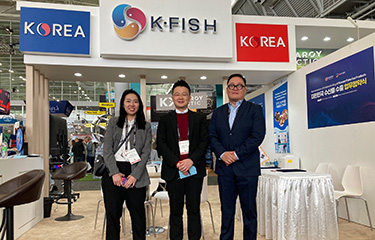Trade officials representing the Asian countries of Japan, Indonesia, and South Korea are hoping the days of dealing with the complications of selling seafood to the U.S. market during the Covid-19 crisis are over.
Hur Soo Youl, the team manager of the international sales department of K-Fish, the promotional group for seafood from South Korea, said the 24 companies in the country’s pavilion at the 2023 Seafood Expo North America were reporting their business interactions were “pretty much back to normal” this year.
“There has been a regular flow of business. We’ve particularly noticed the Chinese vendors are back this year,” he said through an interpreter. “Because of Covid we weren’t as active, but we’re here now to aggressively promote Korean seafood.”
Hur said the companies in the Korean pavilion were marketing live crab, flounder and other flatfish, organic seaweed, frozen oysters, and abalone at Seafood Expo North America.
“The U.S. market has such potential, but U.S. seafood consumption is so limited,” Hur told SeafoodSource. “We are trying to continue to serve the ethnic market through stores like HMart, while also making products suitable for the mainstream retail and foodservice market.”
Hur said Korean seafood companies targeting the U.S. market are focused on two trends: health-consciousness and value-added products for home dining.
“People want healthy food, and people are eating more at home now,” he said. “With the economy and inflation, things are getting expensive, so we want to have products for people eating at home instead of dining out.”
Dongwon Industries is by far South Korea’s largest seafood company, and Hur acknowledged Dongwon’s market research and development resources are much larger this his own agency’s.
“We’re here to help out the seafood producers that are not as big as Dongwon, the smaller producers that are just getting started in exporting. We aim to help them export to the United States, and also to educate them on U.S. import rules.”
Berny A. Subki, the director the Indonesia Ministry of Marine Affairs and Fisheries Directorate of Logistics, said the 14 companies that participated in Seafood Expo North America as part of the Indonesian Pavilion had banked more than USD 13 million (EUR 12.3 million) in deals on the show floor, in line with expectations.
“We are back in terms of production and exports,” Subki said. “Also, cargo prices have been improving, so now it's getting normal and getting better after the problems we had during the pandemic.”
The pandemic provided a “blessing in disguise” in giving Indonesian seafood companies and the Indonesian government time and space to improve quality control and production improvements, Suki said.
“We had two years to improve and to change some or to correct some of the mistakes that we had in previous times,” he said. “Now we are optimistic to be back in the global markets in better shape.”
Indonesia is one of the top shrimp, tuna, pangasius, and blue swimming crab exporters to the United States, and Subki said his country’s government and seafood industry believe there is additional room for growth in those species, as well as other species like tilapia.
“We are quite optimistic,” he said. “We also hope to see U.S. seafood consumption growing, which will help the Indonesian people and factories.”
With so many different species in play, Subki said his agency stays busy maintaining a steady stream of communications with Indonesian seafood firms looking to do business in the U.S., especially regarding import rules and best practices.
“The main target is to return to the situation that Indonesia reached before the pandemic. “We are seeing from the results of the previous year, 2022, very significant progress and there is hope that we can improve more in the coming [year] and future years.”
At the Japan Pavilion, 13 companies exhibited this year, led by Japan External Trade Organization (JETRO) Executive Director Hideyuki Takahashi. He said word amongst his exhibiting firms was that traffic and business was up at this year’s expo.
“We have had a lot more people coming by, and I would guess the results out of the show will be higher compared with last year,” he said.
The companies in the Japan Pavilion were selling a range of products, but hamachi and octopus were species of emphasis at this year’s expo, according to Takahashi.
He said the differentiator for Japanese seafood in the U.S. market is the technology that the country’s seafood providers apply to their processes to ensure the best quality and taste.
“This is something which is unique to Japan,” he said. “When you see our product compared to others, you can easily tell the difference.”
Asked what his main goal is at Jetro, Takahashi said it touting Japanese products in the U.S. market.
“Japan has a lot to offer,” he said. “So I would like U.S. consumers to select Japanese [products].”
Photo courtesy of Cliff White/SeafoodSource







